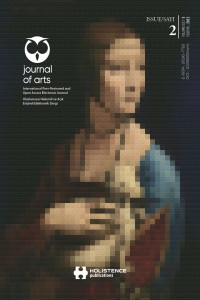Öz
In contemporary art, the works, which use skin color as a surface effect that surrounds the object to produce anthropomorphic metaphors suppressing all other physical features of the body that offer a clue to identity, offers a wide-angle view of human situations by anonymizing the subject, and thus creating a transcendent expression of gender, race, ethnicity and class categories.This approach, which eliminates the distance between bodies and creates experiences such as self-reflexivity, empathy and relationality, has gained momentum since the 1980s with the widespread use of materials whose natural structure gives skin effect. In the 1990s the studies of feminist thinkers such as Judith Butler, Susan Bordo, Elizabeth Grosz, Moira Gatens, and Gail Weiss on body images and experiences in the cultural context, and anti-patriarchal and post-structuralist approaches to gender and identity issues have also enriched the thougts on the skin. Skin representations, as a product of science and medicine in the modern period in art history, take place in our time as an independent subgenre of contemporary portraits and an object of popular visual culture.In this text, which suggests that this approach creates a sub-genre that can be defined as ‘Skin Portrait’, the works of artists that visualize skin color connotations and psychological metaphors of different human situations are examined.
Anahtar Kelimeler
Kaynakça
- BATAILLE, G. (1997) Eros’un Gözyaşları (Çev: M. Yakupoğlu) Göçebe Yay. Araştırma Dizisi: 17, 1.Basım, İstanbul
- BENTHIEN, C. (2004) Skin: On The Cultural Border Between Self And The World, Columbia University Press, New York
- CONNOR, S. The Book of Skin (2003) Cornell University Press, New York
- FREUD, S. (1923) The Ego and the Id, trans. J. Riviere and Ed. J. Strachey, (W.W. Norton & Co., 1960, New York)
- FOSTER, H. (2004) Tasarım ve Suç, Çev: E.Gen, İletişim Yay., 1.Baskı, İstanbul
- HOPKINS, D. (2000) After Modern Art 1945-2000, Oxford University Press
- JAMESON, F. (1994) Postmodernizm ya da Geç Kapitalizmin Kültürel Mantığı, Çev. N. Plimer YKY, 1. Baskı, istanbul
- SCOTT, J., (2014) Language Of Mixed Media Sculpture, The Crowood Press Ltd Ramsbury, Marlborough Wiltshire SN8 2HR www.crowood.com
- SEITZ, W. C. (1961) The Art Of Assemblage, The Museum of Modern Art: Distributed by DoubledaY, www.moma.org/calendar/exhibitions/1880
- WILSON, S. (1995) Bataille - Writing The Sacred içinde ‘Fêting the Wound: Georges Bataille and Jean Fautrier in the 1940s’, Routledge Yay. Londra
- ALTINYILDIZ ALTUN, N. (2014, Mayıs) Sunuş/Mimarlığı Baştan Çıkarmak (Online Dergi) E SKOP, Sayı:6 Erişim Tar: 14/08/2021:https://www.e-skop.com/skopdergi/sunus-mimarligi-bastan-cikarmak/1930
- HONIGMAN, A.F., (2002, Aralık) Assaulting the Surface: A Conversation with Sarah Lovitt, (Online Dergi) Sculpture, A Publication of the International Sculpture Center, https://sculpturemagazine.art/assaulting-the-surface-a-conversation-with-sarah-lovitt/
- BAYRAKTAR, K.O., (2021) Dünyanın Haritaları, Sanatorium,http://keremozanbayraktar.com/wp-content/uploads/2021/05/Kerem-Ozan-Bayraktar-Dunyalarin-Haritalari-2021-Mayis.pdf
- KELLETT, H. (2017) Skin Portraiture: Embodied Representations in Contemporary Art. (Yayınlanmamış Doktora Tezi) Western Ontario Üniversitesi (Supervisor Dr. Joy James, Graduate Program in Visual Arts )
- WATSON, A.K. (2010) Complexion: Skin, Surface and Depth in Contemporary Art Practice (Yayınlanmamış Doktora Tezi) Witwatersrand Üniversitesi, Johannesburg
Öz
Çağdaş sanatta antropomorfik metafor üretmek için nesneyi kuşatmış bir yüzey etkisi olarak ten rengini kullanan, bedenin kimliğe dair ipucu sunan tüm diğer fiziki özelliklerini geri plana iten yapıtlar, özneyi anonimleştirerek cinsiyet, ırk, etnik köken ve sınıf kategorilerini aşkın bir ifade, insani durumlara ait geniş açılı bir anlatıma imkan tanımaktadır. Bedenler arasındaki mesafeyi yok eden, özdüşünümsellik, empati ve ilişkisellik gibi deneyimleri doğuran bu yaklaşım doğal yapısı ten etkisi veren malzemelerin yaygın kullanımıyla 1980’lerdan itibaren hız kazanmıştır. 1990’larda Judith Butler, Susan Bordo, Elizabeth Grosz, Moira Gatens, ve Gail Weiss gibi feminist düşünürlerin kültürel bağlamda beden imajları ve deneyimleri üzerine çalışmaları ve cinsiyet ve kimlik konularına yönelen anti-ataerkil ve postyapısalcı yaklaşımlar tene bakışı da zenginleştirmiştir. Sanat tarihinde modern dönemde bilim ve tıbbın bir ürünü olarak ten temsilleri zamanımızda çağdaş portrelerin bağımsız bir alt türü ve popüler görsel kültürün bir nesnesi olarak yer almaktadır. Bu yaklaşımın ‘Ten Portresi’ diye tanımlanabilecek bir alt tür oluşturduğunu öneren bu metinde sanatçıların ten rengi çağrışımları ile farklı insani durumlara ait psikolojik metaforları görselleştiren yapıtları incelenmektedir.
Anahtar Kelimeler
Kaynakça
- BATAILLE, G. (1997) Eros’un Gözyaşları (Çev: M. Yakupoğlu) Göçebe Yay. Araştırma Dizisi: 17, 1.Basım, İstanbul
- BENTHIEN, C. (2004) Skin: On The Cultural Border Between Self And The World, Columbia University Press, New York
- CONNOR, S. The Book of Skin (2003) Cornell University Press, New York
- FREUD, S. (1923) The Ego and the Id, trans. J. Riviere and Ed. J. Strachey, (W.W. Norton & Co., 1960, New York)
- FOSTER, H. (2004) Tasarım ve Suç, Çev: E.Gen, İletişim Yay., 1.Baskı, İstanbul
- HOPKINS, D. (2000) After Modern Art 1945-2000, Oxford University Press
- JAMESON, F. (1994) Postmodernizm ya da Geç Kapitalizmin Kültürel Mantığı, Çev. N. Plimer YKY, 1. Baskı, istanbul
- SCOTT, J., (2014) Language Of Mixed Media Sculpture, The Crowood Press Ltd Ramsbury, Marlborough Wiltshire SN8 2HR www.crowood.com
- SEITZ, W. C. (1961) The Art Of Assemblage, The Museum of Modern Art: Distributed by DoubledaY, www.moma.org/calendar/exhibitions/1880
- WILSON, S. (1995) Bataille - Writing The Sacred içinde ‘Fêting the Wound: Georges Bataille and Jean Fautrier in the 1940s’, Routledge Yay. Londra
- ALTINYILDIZ ALTUN, N. (2014, Mayıs) Sunuş/Mimarlığı Baştan Çıkarmak (Online Dergi) E SKOP, Sayı:6 Erişim Tar: 14/08/2021:https://www.e-skop.com/skopdergi/sunus-mimarligi-bastan-cikarmak/1930
- HONIGMAN, A.F., (2002, Aralık) Assaulting the Surface: A Conversation with Sarah Lovitt, (Online Dergi) Sculpture, A Publication of the International Sculpture Center, https://sculpturemagazine.art/assaulting-the-surface-a-conversation-with-sarah-lovitt/
- BAYRAKTAR, K.O., (2021) Dünyanın Haritaları, Sanatorium,http://keremozanbayraktar.com/wp-content/uploads/2021/05/Kerem-Ozan-Bayraktar-Dunyalarin-Haritalari-2021-Mayis.pdf
- KELLETT, H. (2017) Skin Portraiture: Embodied Representations in Contemporary Art. (Yayınlanmamış Doktora Tezi) Western Ontario Üniversitesi (Supervisor Dr. Joy James, Graduate Program in Visual Arts )
- WATSON, A.K. (2010) Complexion: Skin, Surface and Depth in Contemporary Art Practice (Yayınlanmamış Doktora Tezi) Witwatersrand Üniversitesi, Johannesburg
Ayrıntılar
| Birincil Dil | Türkçe |
|---|---|
| Bölüm | Araştırma Makalesi |
| Yazarlar | |
| Yayımlanma Tarihi | 1 Mayıs 2022 |
| Yayımlandığı Sayı | Yıl 2022 Cilt: 5 Sayı: 2 |

